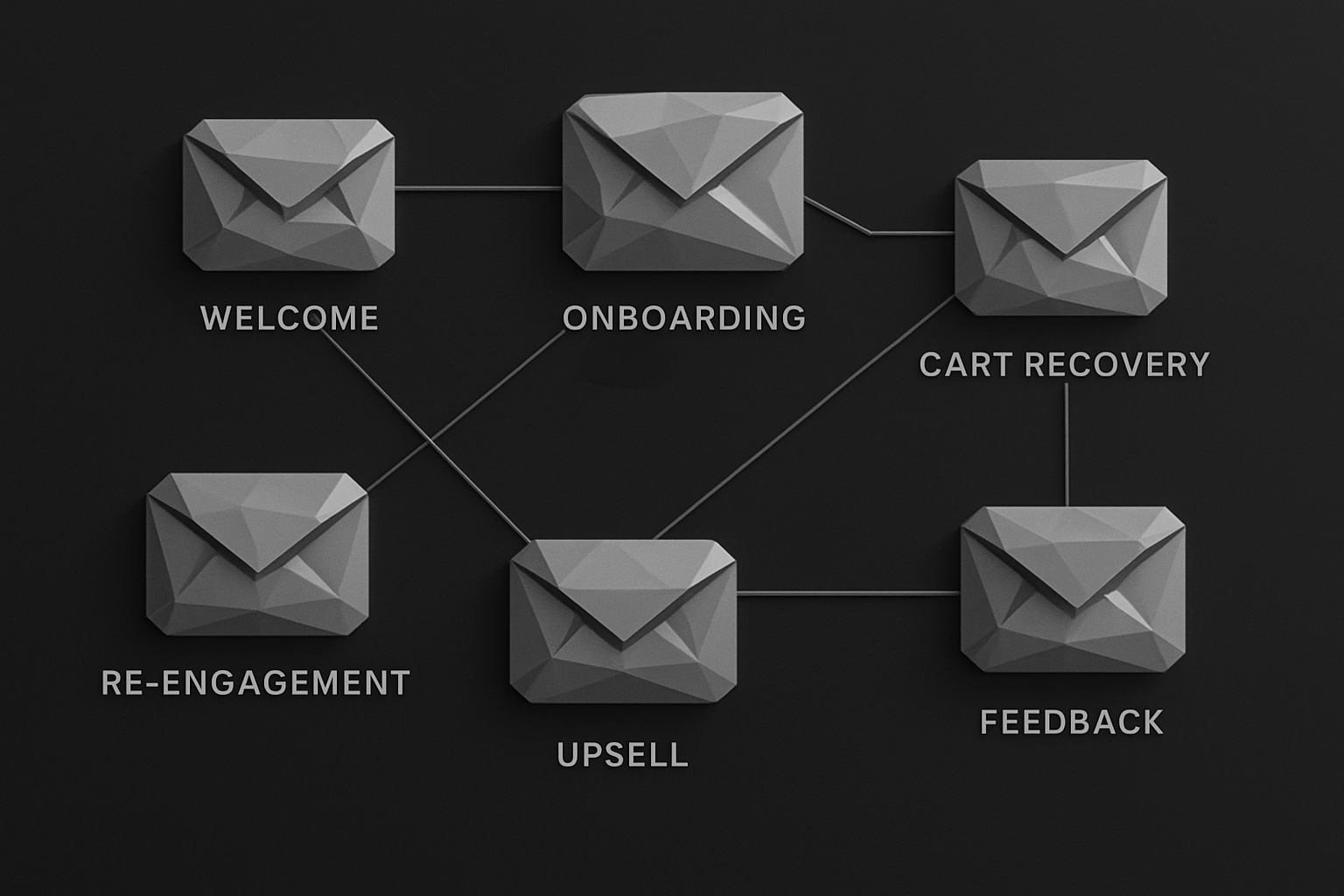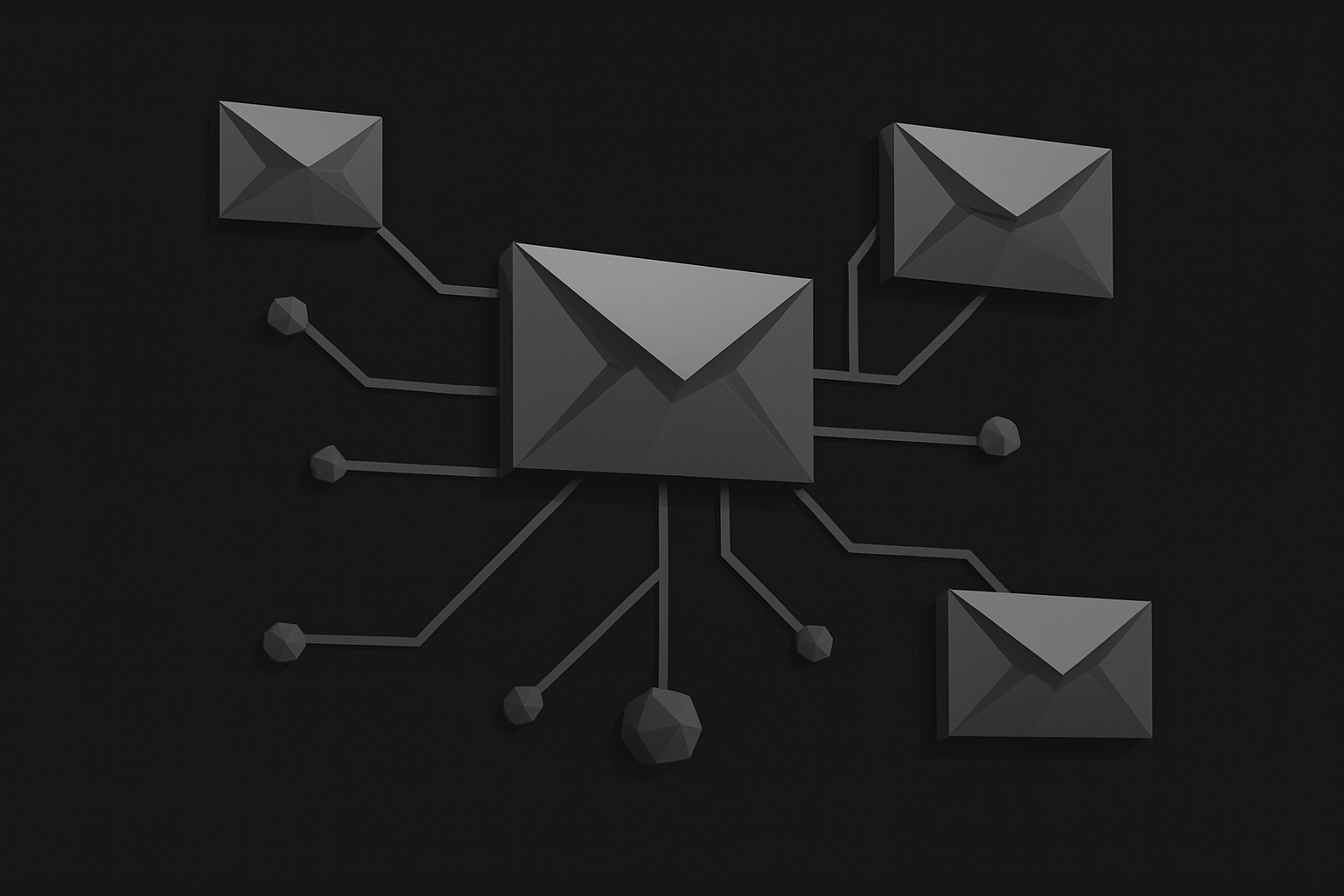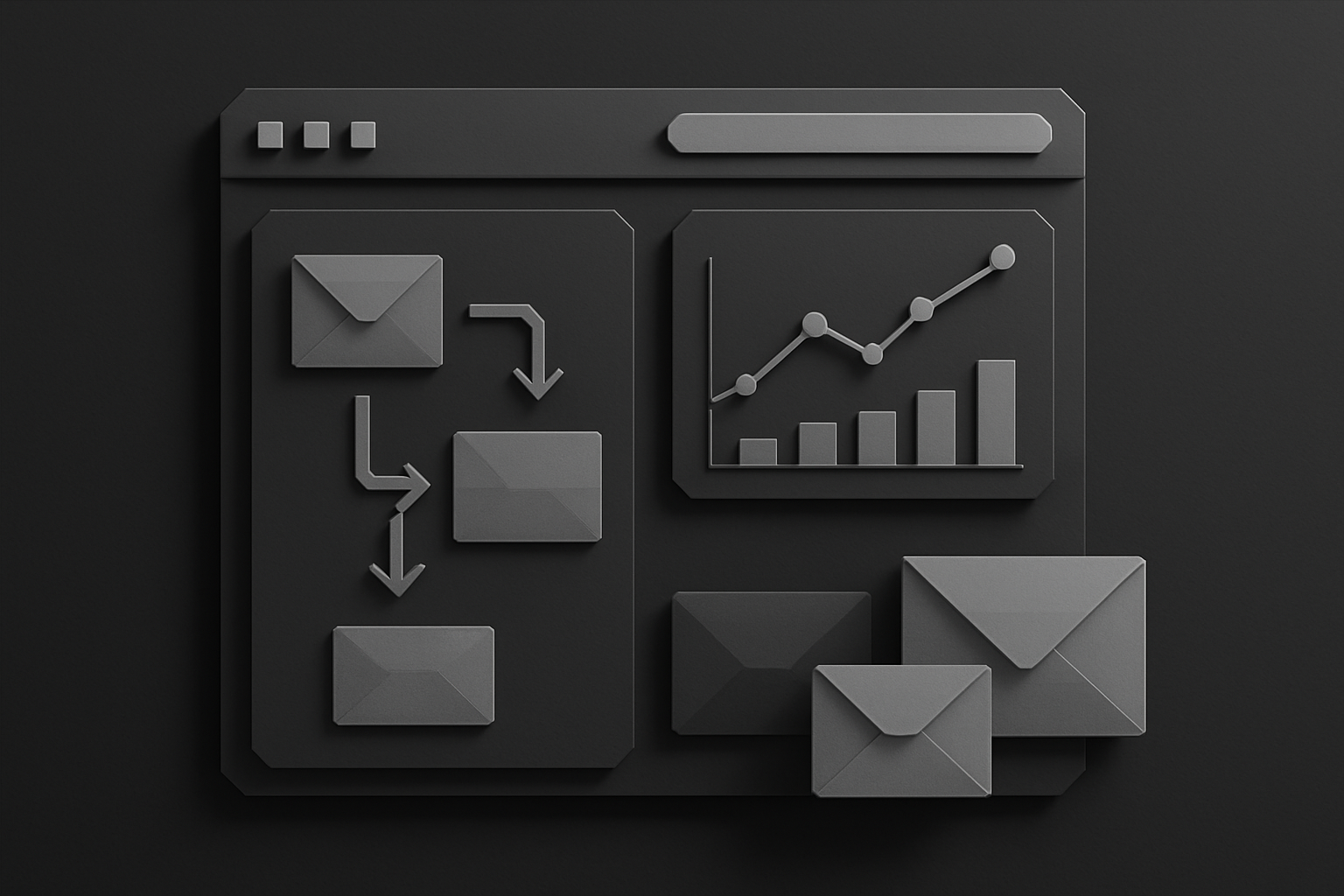Did you know that over 347 billion emails are sent every day, yet only a small fraction truly capture attention? For digital marketers and business owners, mastering the art of the email sequence is now essential for standing out in crowded inboxes.
Many struggle with low engagement and missed opportunities as traditional one-off blasts fall flat. The stakes are higher than ever as audiences demand timely, relevant communication that guides them through every stage of their journey.
That’s why this article reveals 7 proven email sequence strategies poised to drive engagement, nurture leads, and boost conversions in 2025. Each approach is tailored to help modern businesses and creators connect, build trust, and ultimately achieve better results.
Ready to transform your email marketing? Dive in and discover actionable solutions designed for success in the year ahead.
The Evolving Role of Email Sequences in 2025
As we move into 2025, the way businesses communicate with their audiences is transforming. The humble email sequence is now the backbone of successful digital marketing, powering relationships and conversions at scale.

The Shift from One-Off Campaigns to Automated Sequences
Gone are the days when marketers relied on a one-size-fits-all blast to reach their entire list. In 2025, the shift to automated email sequence campaigns is clear.
With automation tools, brands can trigger messages based on a subscriber’s actions—like signing up, making a purchase, or even abandoning a cart. This approach ensures every recipient gets timely, relevant content, increasing engagement and loyalty.
Competitor data from Mailchimp reveals that using an email sequence can significantly boost customer retention. For instance, lifecycle emails nurture subscribers from welcome to re-engagement, while drip campaigns guide prospects through complex funnels. Dynamic automation even allows for real-time adjustments, responding to user behavior instantly.
This evolution helps marketers create a seamless experience, where every email feels like a natural next step.
Why Email Sequences Matter More Than Ever
Inboxes are more crowded than ever, making it a real challenge to stand out. That’s why a well-crafted email sequence is essential for capturing—and keeping—attention in 2025.
According to SendX, sending more targeted emails results in higher engagement and more sales opportunities. Email sequence strategies that leverage segmentation can double or even triple conversion rates, simply by sending the right message at the right time.
Timing is everything, especially as audiences expect instant and relevant content. A modern email sequence adapts to each recipient, making every email feel personalized and timely. This relevancy not only improves open rates but also builds trust, which is crucial in a competitive digital landscape.
Key Benefits for Businesses and Creators
For businesses and creators alike, embracing the email sequence means working smarter, not harder. Automation saves valuable time, allowing teams to focus on strategy while sequences run in the background.
Nurturing leads through an email sequence increases ROI throughout the customer journey. According to email marketing ROI statistics, well-optimized sequences consistently outperform single campaigns in both engagement and sales.
B2B companies use onboarding and nurture sequences to educate prospects. E-commerce brands recover lost sales with abandoned cart emails. Digital product creators build communities and loyalty with regular, value-driven content.
The result? Stronger relationships, higher lifetime value, and a scalable way to connect with every subscriber.
7 Proven Email Sequence Strategies for 2025 Success
Email sequence strategies are evolving fast in 2025. With inboxes more crowded than ever, businesses and creators need smarter ways to connect, nurture, and convert. Below, we break down seven proven email sequence tactics—each designed to maximize engagement, streamline customer journeys, and boost conversions for modern digital marketers.

1. Welcome Sequence: Making a Powerful First Impression
A welcome email sequence is your digital handshake. It’s the first step in turning a new subscriber into a loyal fan. Compared to one-off emails, a well-planned welcome sequence sets expectations, introduces your brand, and guides users on what to do next.
Best practices for a welcome email sequence include using a friendly tone, clear calls to action, and a design that matches your brand’s vibe. Brands like Frame.io and Evercoach excel by sending a series of emails that showcase benefits, offer exclusive content, and encourage engagement. Data shows welcome emails generate 86% higher open rates than standard campaigns—a powerful argument for prioritizing this sequence.
To maximize impact, include a request for users to whitelist your address, offer special incentives, or share a piece of exclusive content. Setting clear expectations about future content ensures subscribers stay engaged and look forward to your next email sequence.
Here’s how a typical welcome sequence might look:
| Email # | Focus | Example CTA |
|---|---|---|
| 1 | Warm greeting | Confirm subscription |
| 2 | Brand story/mission | Explore your dashboard |
| 3 | Bonus content/incentive | Download guide |
Frame.io, for example, saw increased trial activations by welcoming users with value-packed messages and step-by-step guidance. Remember, your welcome email sequence is the foundation for all future interactions.
2. Onboarding Sequence: Guiding Users to Their "Aha" Moment
An onboarding email sequence is different from a welcome sequence. While the welcome sets the stage, onboarding guides users to discover real value—helping them reach that all-important "aha" moment with your product or service.
A highly effective onboarding email sequence focuses on educating users about features, offering tips, and personalizing timing to match user activity. Headspace, for instance, sends daily trial emails that encourage new users to try meditation, highlighting benefits and step-by-step instructions.
To boost engagement, segment your onboarding sequence based on user actions (e.g., which features they’ve tried). This ensures every email sequence is tailored and relevant. Statistics show that well-crafted onboarding sequences can increase retention rates by up to 50% and drive trial-to-paid conversions.
Here’s a step-by-step onboarding sequence example:
- Welcome & Quick Start: Highlight core features.
- Deep Dive: Offer tutorials or video walkthroughs.
- Inspire: Share success stories or testimonials.
- Personalize: Suggest actions based on user behavior.
By mapping onboarding emails to user milestones, you keep engagement high and help users succeed. Every onboarding email sequence should make it easy for subscribers to take the next step and experience your product’s value.
3. Abandoned Cart Sequence: Recovering Lost Sales
Cart abandonment is a revenue leak for e-commerce and digital businesses alike. An abandoned cart email sequence is your opportunity to recover lost sales by nudging users who left items behind.
Timing is crucial. Start your abandoned cart sequence with an immediate reminder, followed by a second email that adds urgency or an incentive (like a discount or free shipping). Brands like Society6 and Casper have mastered the art of creative, friendly reminders that include product images and personalized recommendations.
According to Mailchimp, a well-designed abandoned cart email sequence can recover up to 10-15% of lost sales. To maximize results, use urgency (countdown timers), clear product visuals, and a light, helpful tone to avoid coming across as pushy.
Sample abandoned cart sequence:
- Email 1 (1 hour after abandonment): Friendly reminder with product image.
- Email 2 (24 hours later): Offer incentive or highlight benefits.
- Email 3 (48 hours later): Last-chance message with urgency.
Keep your abandoned cart email sequence concise and focused on helping, not hassling. A thoughtful approach can turn lost opportunities into loyal customers.
4. Re-Engagement Sequence: Winning Back Inactive Subscribers
Over time, even the best lists see subscribers go cold. A re-engagement email sequence is designed to win back users who haven’t opened or interacted with your emails in a while.
Triggers for a re-engagement email sequence typically include inactivity for a set period (like 60 or 90 days) or a lack of recent purchases. Return Path’s approach involves asking users to update their preferences or confirm continued interest—empowering subscribers to choose whether to stay or go.
Data shows re-engagement sequences can reactivate up to 25% of inactive users. To stand out, use compelling subject lines, offer incentives (discounts or exclusive content), and segment your list to tailor messaging.
Tips for a winning re-engagement sequence:
- Use curiosity or empathy in subject lines (“We Miss You!” or “Is This Goodbye?”)
- Offer a simple way to stay subscribed or opt out
- Reward re-engagers with a thank-you or bonus
Here’s a sample sequence:
- Email 1: Friendly check-in, invite to update preferences
- Email 2: Special offer or exclusive content
- Email 3: Final notice before removal
A re-engagement email sequence not only boosts list health but also strengthens your brand’s reputation for respecting user choices.
5. Nurture Sequence: Converting Leads into Customers
A nurture email sequence is the engine that moves leads through your funnel. By delivering helpful, relevant content, you build trust and guide prospects toward becoming paying customers.
Start by segmenting your email sequence based on lead source, behavior, or intent. Mailchimp recommends aligning nurture content with each subscriber’s stage in the customer journey. Effective nurture sequences include educational resources, case studies, and social proof like testimonials.
According to SendX, nurtured leads make 47% larger purchases than non-nurtured leads. The key is to provide consistent value and clear next steps in every email sequence.
Sample nurture sequence flow:
| Step | Content Type | CTA Example |
|---|---|---|
| Awareness | Educational blog post | Read more |
| Consideration | Case study/testimonial | See results |
| Decision | Free trial/demo offer | Start now |
Timing and frequency matter. Space out your nurture email sequence to avoid overwhelming subscribers. For more on nurturing leads, check out these lead generation strategies for digital products.
A well-crafted nurture email sequence turns curiosity into commitment, driving conversions and long-term loyalty.
6. Upsell & Cross-Sell Sequence: Maximizing Customer Value
Once you’ve earned a customer, an upsell and cross-sell email sequence can boost their lifetime value. Upsell sequences recommend premium versions or add-ons, while cross-sell sequences suggest complementary products or services.
Companies like Airbnb and Service Provider Pro excel at sending timely, personalized recommendations after a purchase. The best upsell and cross-sell email sequences avoid aggressive sales tactics, focusing instead on relevance and genuine value.
Personalized recommendations in an email sequence can increase average order value by 10-30%. To maximize results, trigger your sequence shortly after purchase and segment offers based on purchase history.
Tips for effective upsell/cross-sell sequences:
- Highlight benefits and use cases, not just features
- Include testimonials or user-generated content for social proof
- Space out emails to avoid overwhelming your customers
Sample sequence:
- Email 1: Thank you and relevant upgrade/cross-sell suggestion
- Email 2: Deeper dive into benefits or a special offer
- Email 3: Reminder with customer success story or review
A strategic upsell and cross-sell email sequence ensures customers feel valued, not sold to—paving the way for increased revenue and satisfaction.
7. Feedback & Testimonial Sequence: Leveraging Customer Voice
Collecting feedback and testimonials is vital for building trust and improving your offerings. A dedicated feedback and testimonial email sequence ensures you capture authentic customer insights at the right moments.
The best time to trigger this email sequence is after a purchase, onboarding, or customer support interaction. Mailchimp recommends making the process simple—think one-click star ratings or direct reply options.
Best practices for a feedback email sequence:
- Use a two-step approach: first, ask for a quick rating; then, invite detailed feedback or a testimonial
- Offer a small incentive (like a discount or entry into a giveaway) to encourage participation—without overdoing it
- Send a follow-up thank-you to those who respond
User-generated reviews drive significantly higher trust and conversions, making this email sequence a must-have. Here’s a sample approach:
- Email 1: Request for quick feedback (rating or single question)
- Email 2: Invitation to share a testimonial or story
- Email 3: Appreciation and optional incentive
A thoughtful feedback and testimonial email sequence not only improves your products but also fuels your marketing with authentic, powerful social proof.
Personalization, Segmentation, and Automation: The Backbone of Effective Sequences
Mastering the art of the email sequence is no longer optional—it's essential for any marketer aiming to thrive in 2025. Today’s subscribers expect more than generic messages. They crave relevant, timely, and personalized content that speaks directly to their needs. That’s why effective email sequence strategies rely on three pillars: segmentation, automation, and personalization.

The Power of Segmentation in Modern Email Marketing
Segmentation is the secret weapon behind a successful email sequence. Instead of blasting the same message to every subscriber, segmentation lets you divide your audience by traits like behavior, purchase history, or engagement level.
Consider these common segmentation strategies for your next email sequence:
- Behavior-based: Target users based on clicks, browsing, or past purchases.
- Engagement level: Separate active from inactive subscribers.
- Demographics: Tailor messages by location, age, or interests.
Segmented campaigns consistently outperform generic ones. According to SendX, segmentation can lead to faster conversions and higher customer value. For example, a B2B business might send a different email sequence to new leads versus long-term clients, each tailored to their needs.
A recent study showed segmented email sequence campaigns increase open rates by up to 14% and click-through rates by 100%. With inbox competition fiercer than ever, segmentation gives your messages the edge they need.
Leveraging Automation for Scale and Efficiency
Automation is the backbone that keeps your email sequence running smoothly, even as your list grows. With automation, you can map out every touchpoint in the subscriber journey and trigger the right message at the perfect moment.
Setting up an automated email sequence usually involves:
- Mapping the journey: Identify when and why each email should be sent.
- Trigger setup: Use actions like sign-up, inactivity, or purchase to initiate workflows.
- Workflow design: Build branches for different subscriber actions.
Mailchimp’s automation features make it easy to deliver timely, relevant content to every segment. For example, an abandoned cart email sequence can automatically follow up with shoppers who didn’t finish their purchase, boosting recovery rates without manual effort.
By automating your email sequence, you save time, reduce errors, and ensure no subscriber falls through the cracks. This frees your team to focus on creative strategy and continuous improvement.
Personalization Beyond the First Name
Personalization in an email sequence goes far beyond inserting someone’s first name. Today, brands leverage dynamic content, personalized product recommendations, and behavioral triggers to make each message feel tailor-made.
Imagine sending a product recommendation based on a subscriber’s browsing history, or a re-engagement email sequence triggered by a month of inactivity. These tactics transform your emails from noise into value.
Brands using advanced personalization report dramatic engagement gains. For instance, Personalized email marketing statistics reveal that personalized email sequence campaigns can increase transaction rates sixfold.
To balance automation and the human touch, always review your automated flows. Make sure every email sequence feels authentic, timely, and truly useful to the recipient.
Best Practices for High-Performing Email Sequences in 2025
To succeed with any email sequence in 2025, you need more than just great content—you need a strategic approach. Modern inboxes are crowded, so it’s essential to refine every step of your process for maximum engagement and results.

Setting Goals and Measuring Success
Start every email sequence project with clear, SMART goals. Define what you want to achieve—whether it’s increasing open rates, boosting conversions, or driving revenue. Identify your KPIs: common ones include open rates, click-through rates, and conversions.
Use analytics tools to track performance and pinpoint where subscribers drop off. This helps you refine your sequence and align it with your business objectives. Many creators use platforms from the best digital marketing tools for creators list to monitor and measure campaign impact efficiently.
Crafting Compelling Subject Lines and CTAs
Your subject line is the first impression for any email sequence. Test different approaches—personalization, curiosity, or urgency—to see what resonates with your audience. Analyze results and iterate on your best performers.
Effective CTAs are clear and action-oriented. Use strong verbs and set clear expectations, like “Download your guide” or “Start your free trial.” Keep subject lines concise and relevant, ensuring they match the email’s content.
Try A/B testing different CTAs within your email sequence to learn what drives the most clicks.
Testing, Iteration, and Continuous Improvement
A/B testing is your best friend for optimizing every email sequence. Test variables like sequence length, content, timing, and design. Small tweaks—such as adjusting send times or refining copy—can yield significant gains.
Leverage automation features to streamline testing and collect data. According to email automation statistics, automated campaigns consistently outperform manual sends. Use these insights to iterate and improve each email sequence over time for better engagement.
Compliance and Deliverability in 2025
In 2025, keeping your email sequence compliant is non-negotiable. Stay updated on regulations such as GDPR and CAN-SPAM. Always include clear unsubscribe options and honor privacy preferences.
Regularly clean your subscriber list to avoid spam traps and bounce rates. Focus on deliverability by authenticating your sending domain and monitoring sender reputation. Following these practices ensures your email sequence reaches inboxes and maintains a strong sender reputation.
Resources for Building and Optimizing Email Sequences
To build a high-performing email sequence, start by choosing reliable tools like Mailchimp, SendX, or ConvertKit. These platforms make it easy to automate, personalize, and track your email sequence results—all essential for success in 2025.
For marketers and business owners looking to maximize impact, further reading is key. Explore strategies for building digital products audience to strengthen your foundation and grow your reach.
Stay connected with email marketing communities and industry blogs. Regularly learning about new trends and technologies ensures your email sequence remains effective and future-proof.
Ready to put these proven email sequence strategies into action and start building a business that works for you—even while you sleep? At CreateSell, we’re all about helping you move from trading hours for dollars to creating digital products that sell themselves. If you’re excited to grow your audience, automate your sales, and turn your expertise into a thriving one-person business, now’s the perfect time to take the next step. Let’s put these ideas to work together—Get Started and set your 2025 up for email marketing success!